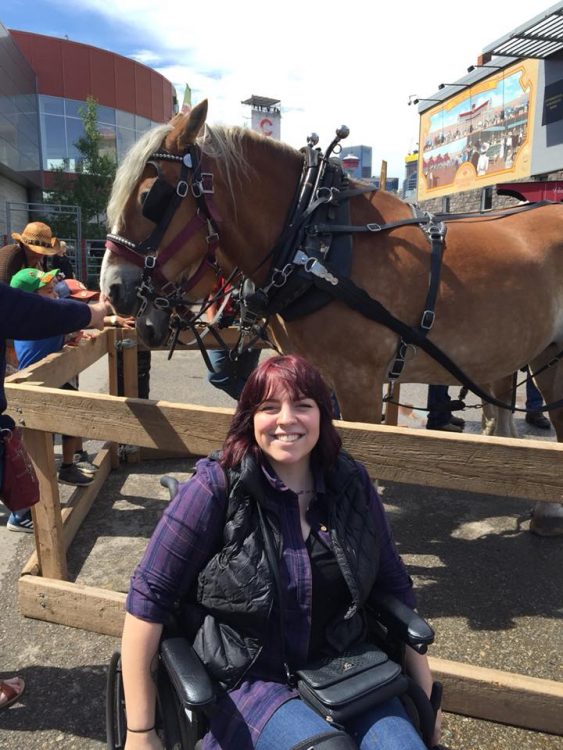When people see seats reserved for disabled people on planes, buses, trains, or at sports or entertainment venues, the first thing that might come to their minds is that those seats are for people who are elderly, use a wheelchair, or are in some way “obviously” disabled. But what they don’t always consider is that you can be disabled and also young or “healthy-looking.” Not all illnesses and disabilities are visible, but that doesn’t make them any less valid — and that doesn’t make a person with an invisible disability any less deserving to sit in a seat reserved for disabled people, or at least sit down somewhere when they need to.
But when people who don’t “look disabled” do use disabled seating, it’s not uncommon for them to face stares, questions and judgment, or demands that they move and let someone else sit there. People with invisible disabilities may be “ignored” instead of helped to priority seating, like this woman was, or asked to justify why they’re sitting there. London’s transportation department even created a badge that says “Please offer me a seat” to help combat the challenges many people have with being able to find seat on the train if they don’t “look disabled.”
You should never feel like you have to “prove” yourself — if you need to sit, you have every right to be there and ignore any doubters. But if people have a better understanding of how invisible disabilities work, hopefully they will be more accepting of others who are sitting when they “look like” they could stand. So we asked our Mighty community with invisible illnesses to share a photo of themselves along with a message they wish they could share with anyone who questions their right to sit. These are the stories any doubters should keep in mind.
Here’s what our Mighty community shared with us:
1. “Accessible seating is important. When I get on a bus I have a decision to make — do I risk walking to the back for a seat when the bus is in transit or do I risk standing? Usually, standing is safer dislocation-wise for me as I’m not moving, but walking on a moving bus can throw my knees out easily. A seat at the front eliminates both scenarios!” — Emily B.

2. “I’m 28. I’ve been told that if I get hospitalized again I may never be able to relearn how to walk. I have Botox in both legs to help me stand up and walk a bit. I’ll walk slow from the disabled parking to the store and use one of theirs to shop because those electric scooters are the only thing safe for me to drive. And I really don’t care what people think when they look at me and see a smile on my face. I know I need it and I know it’s easier to grab it than having my girlfriend getting mine off my trunk.” — John N.

3. “This picture was taken shortly before and after multiple seizures. I cannot stand for prolonged periods and sometimes I need to sit immediately to avoid collapsing, so I can sit quietly and disturb no one or I can collapse and/or seize dramatically on the floor. I often get dirty looks for using priority seating as I don’t look like I need it, but not all disabilities are visible and, if you could see my vitals change second to second, you’d realize I’m not faking or overplaying my needs.” — Shannon B.

4. “I remember one time specifically I sat as I knew my knee was about to dislocate and at the same time I was trying to stop my baby crying, wishing I wasn’t ill and that I could walk around to comfort him and a man was tutting I wasn’t giving his wife the last space on a bench. I understand that I look well but I wish people thought of invisible illnesses!” — Sian M.

5. “This is me on the left. I look like I’m perfectly healthy, my son is perfectly healthy and we’re all just posing for a happy pic, blah blah, but I’m always in pain, I threw up probably five times that day, I was already limping and my son in the blue shirt was in pain and was so hot that he threw up minutes later after about 10 minutes of walking — yes we sat him down, cooled him down and gave him water and went home.” — Jennah M.

6. “I have linear IGA disease. I have had pneumonia three times in the last year due to the disease attacking my lungs. I have had chemotherapy to try and resolve symptoms unsuccessfully. I am constantly tired and in pain but yet try to appear well for my family and my job.” — Mhari E.

7. “I’m young and athletic-looking, so people don’t get that I have mobility issues. I need to use disabled seating on public transit usually because I’m fatigued, in pain, or can’t balance while the bus is moving. I also have my service dog with me, and disabled seating on public transit usually means I have room for my medical equipment. Not all disabilities are invisible, and mine is none of your business. You don’t have the right to question me or police the disabled seating. It won’t hurt you to move to another seat or stand for a bit, but it would probably hurt me.” — Alex P.

8. “This is my partner, he looks physically fit and strong. He tries to do everything he can, even though he is in pain 24/7. He has degenerative disc disease and fibromyalgia.” — Sieanne P.

9. “I have Crohn’s disease, gastroparesis, fibromyalgia, and arthritis. These conditions make it hard for me to stand for a long time. Depending on what I’m wearing, you can’t see my Hickman line that I use for TPN. I need to sit.” — Brandy F.

10. “I know you don’t see illness. I know what that flicker across your face is. I look ‘normal’ to you and you don’t know why I need the seat. And I’m sorry you haven’t been educated that what you see is not all you get. But really, it doesn’t matter. It’s not actually your business. It’s about being kind and trusting others. If you think I’m ‘scamming you’ for the seat — that’s about your trust for the world and people in it. Open your eyes — look up! And sit in the disabled seat last, please — even if the rest of the carriage is empty, down the line it won’t be and I need to be able to get to the doors when the train has stopped. If I stand up before then we could be stopping for a whole lot longer while you carry me off the train!” — Sophie C.

10. “This is me in a wheelchair at YYC Stampede. Long periods of walking make me very ill and faint, it also causes me joint and muscle pain and disabling fatigue. I sit in the disabled seating on buses because I feel shaky, lightheaded, air hungry and fatigued. Standing puts me at risk for knee subluxations or injury from falling over. I’m only 20, I get a lot of curious looks but I’m always happy to educate people if they politely ask!” — Tessa H.


